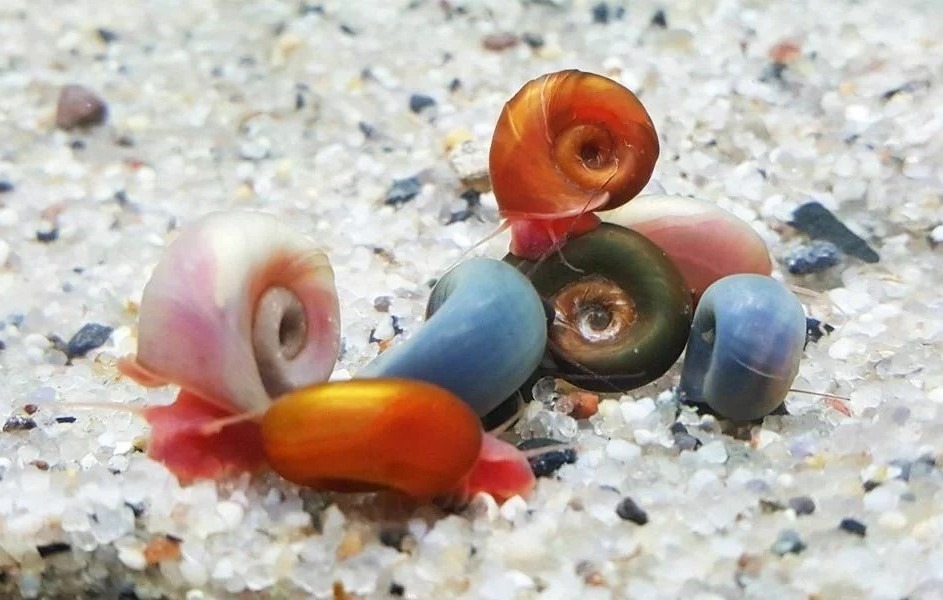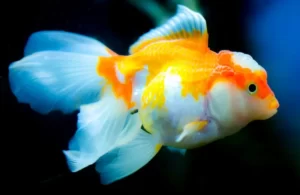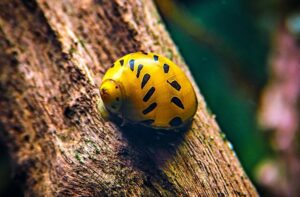
Ramshorn Snail Care: Food, Breeding, Tank Mates & More

Writer at The Aquarium Keeper
Ramshorn snails are one of those polarizing invertebrates that can be a pet for some and a pest for others. Under the right circumstances, they do make great pets as they have an interesting appearance and have the ability to clean aquariums by eating algae and other debris. They are also one of the hardest invertebrates around.
They are considered pests because they can come as uninvited guests on newly purchased plants and decor and once they get established in a tank, it is almost impossible to completely eradicate them. This should not discourage you though as by taking a few simple steps, you can ensure that they are beneficial to your tank. Today, I will discuss these steps as well as everything involved in properly caring for these amazing creatures so that keeping them becomes a positive experience for both you and the ramshorn snail.
Ramshorn Snail Etymology
The term “ramshorn” is used to describe the coiled shape of the shell of the snail, which resembles the shape of a ram’s (male goat) horn. There are multiple species that are referred to by this name but a majority of them belong to the family Planorbidae.
This name comes from the combination of two Greek words: “planos,” meaning “flat,” and “orbein,” meaning “to orbit” or “to circle”, a manner of describing their shell shape. The suffix “-idae” is commonly used in biology to indicate a family of related organisms.
Ramshorn Snail Appearance
Ramshorn snails have a very distinctive appearance. Their shells are coiled, circular, or spiral-shaped, with a flattened spiral on top. The size of the shell can vary from a fraction of an inch to an inch in diameter, depending on the species.
The shells of ramshorn snails can be of various colors, including brown, gray, black, and even red. The red variant is the most popular when it comes to pet snails. Some species have a translucent shell that allows you to see their internal organs.

Ramshorn snails have a soft body with a pair of tentacles on their head, which they use for sensing their environment and finding food. Their body is usually grayish in color and can range from almost transparent to opaque, depending on the species and the individual snail’s diet.
One unique feature of ramshorn snails is that they have the ability to breathe air. They have a modified respiratory system that allows them to take in oxygen from both the air and the water, which helps them survive in environments where oxygen levels may be low.
Ramshorn Snail Behaviour
Moving on, ramshorn snails are really peaceful creatures and literally don’t care about anything. If there is enough food, and water conditions are right, these creatures will happily live without a problem. Snails tend to not care too much about their environment, and keep everything to themselves. This is also the case for ramshorn snails, they are not aggressive, and compatible with most aquatic creatures.
Ramshorn Snail Tank Setup
Ramshorn snails are relatively easy to care for and can thrive in a range of tank setups. Here are some general guidelines for setting up a tank for ramshorn snails:
- Tank size: Ramshorn snails are relatively small and don’t need a large tank to thrive. A 10-gallon tank can accommodate a small group of snails, but larger tanks are recommended if you want to keep fish and/or other invertebrates with these snails.
- Substrate: Ramshorn snails like to burrow in the substrate, so provide a soft substrate that they can easily move through. Sand or fine gravel is a good option.
- Filtration: A good quality filter is essential for keeping the water clean and clear. Ramshorn snails can produce a lot of waste, so a filter with a high turnover rate is recommended. You should get at least a filter, that is capable of filtering twice as much water per hour as you have in your aquarium (for a 10-gallon tank you would need a filter, that can handle 20 gallons per hour).
- Decorations: Ramshorn snails like to climb and explore their environment, so adding decorations like rocks, driftwood, and plants can provide them with plenty of opportunities to do so. Plants are actually an essential part of ramshorn snail care, since they clean water, provide shade, and even food for ramshorn snails. Although snails are sometimes known for uprooting aquarium carpeting plants.
Overall, setting up a tank for ramshorn snails is relatively straightforward and doesn’t require any specialized equipment. With a little bit of care and attention, these fascinating snails can thrive in a range of freshwater environments.
Ideal Water Parameters For Ramshorn Snail
Ramshorn snails are hardy and adaptable creatures that can survive in a wide range of water conditions. However, to keep them healthy and thriving, it’s crucial to maintain certain water parameters. Ideally, the water parameters should be as follows
- Temperature: Between 18°-28°C (65°-82°F)
- pH level: Between 7.0 and 8.0
- Water hardness: Between 6-20 dGH or 107-357 ppm
Additionally, the water should be free of ammonia, nitrite, nitrate, and copper. Ramshorn snails don’t react well to these materials, so be sure to test your water source beforehand, to ensure the safety of your pets.
Ramshorn Snail Diet
Ramshorn snails are scavengers and will eat almost anything that they come across in their environment. In the wild, they feed on algae, decaying plant matter, and small aquatic organisms. In an aquarium setting, they will feed on leftover fish food, dead or decaying plant matter, and even fish waste. You can supplement this using algae wafers, blanched vegetables like zucchini or spinach, and commercial snail food. You only need to do this once a week as excess food can lead to water quality issues.
Ramshorn Snail Tank Mates
Ramshorn snails can make great additions to freshwater community aquariums, but choose tankmates carefully to ensure these snails don’t end up as prey. Some fish, such as cichlids, loaches, and puffers, and invertebrates such as assassin Snails and crayfish are known to prey on snails and can quickly decimate a population of ramshorn snails. It’s best to choose peaceful community fish and invertebrates. Here are some great tankmates for this snail:
- Community fish such as tetras, guppies, rasboras, mollies, and platies.
- Peaceful bottom-dwelling fish such as corydoras catfish, bristlenose plecos, and otocinclus catfish.
- Small crustaceans like neocaridina shrimp.
- Small and peaceful snail species such as nerite snails, or rabbit snails.
How to Control Ramshorn Snail Breeding
Normally at this point, I’ll be discussing the best method for breeding but with the ramshorn snail, breeding is as easy as it gets. As long as there are multiple individuals in a tank, they will breed. This is because ramshorn snails are hermaphrodites, meaning they possess both male and female reproductive organs. They can self-fertilize or mate with another snail to produce offspring and they will do so with very little encouragement.
They can quickly overpopulate a tank if their numbers are not managed and keeping their population under check is often the bigger concern. Here are some tips on how to control ramshorn breeding:
- Limit feeding: Overfeeding can lead to an increase in the snail population. Reduce the amount of food you provide to limit their growth.
- Manual removal: Regularly remove visible snail egg clutches and adult snails from the tank to prevent them from hatching and reproducing.
- Introduce predators: Some fish and invertebrates, such as assassin snails, pea puffers, and loaches, can help control ramshorn snail populations by preying on them.
- Adjust water parameters: High temperatures and pH levels can promote snail breeding. Adjusting these parameters can help slow down their reproduction.
- Use snail traps: Commercial snail traps can be used to remove adult snails from the tank. Place the trap in the tank at night, when the snails are most active, and remove it in the morning with the trapped snails.

If you are reading this because you see these snails as pests and want to eradicate them then remember that complete elimination of ramshorn snails is not necessary or even needed. They play a beneficial role in the aquarium ecosystem. Controlling their population can prevent them from becoming a nuisance and help you enjoy them as the pets they are meant to be.
Ramshorn Snail Common Diseases and Treatments
Ramshorn snails are among the hardiest and disease-resistant snails out there, but like all living creatures, they can still fall ill. Here are some common diseases that ramshorn snails may face and their treatments:
- Shell damage: Ramshorn snails have delicate shells that can crack or break if they are handled roughly or if they fall from a height. If the shell is damaged, the snail may be vulnerable to infection and may require treatment with a topical antibiotic. Make sure that the water parameters are appropriate to promote shell healing.
- Parasites: Ramshorn snails can be susceptible to internal and external parasites. Symptoms may include a loss of appetite and lethargy.
- Water quality issues: Poor water quality can lead to a variety of health issues for ramshorn snails, including stress, infections, and lethargy. Regular water changes and monitoring of water parameters can help prevent these issues.
- Calcium Deficiency: This can lead to weak shells that can lead to secondary issues. Provide them with a calcium-rich diet to help with this.
- Copper poisoning: Like all invertebrates, ramshorn snails can become seriously ill if there is copper in the water. Avoid copper fittings inside the tank and make sure that any medication used in the tank is copper-free.
As long as the tank is clean and well-maintained, you won’t have to worry about these snails getting sick. Although all of these issues can easily lead to a dead snail in an aquarium, so be sure to treat ramshorn snails right!
Frequently Asked Questions
Do Ramshorn Snails Reproduce Quickly?
Ramshorn snails have the ability to reproduce quickly, especially in optimal conditions. They can lay up to 100 eggs at a time and can produce multiple batches of eggs throughout their lifespan.
Can Ramshorn Snails Live in Cold Water?
Ramshorn snails are adapted to live in warm freshwater environments and may not survive in cold water temperatures.
Writer's Thoughts
Ramshorn snails are fascinating and relatively easy to care for. They can be a valuable addition to an aquarium ecosystem, as they help to clean up algae and other debris. One caveat to keep in mind is their potential for rapid reproduction. Take steps to control their population if necessary.
Maintaining a clean and stable aquarium environment with appropriate water parameters, providing a varied and balanced diet, and avoiding overcrowding are all key to keeping ramshorn snails healthy and thriving. With proper care, these snails can be a great addition to any aquarium and can provide both utility and enjoyment for their owners.
If you enjoyed reading our article, please feel free to share it with your friends by clicking the social media buttons below:


What Vegetables Can Guppies Eat? Vegetable Preparation Guide


Goldfish With Bump On Head: Possible Causes, Dangers & Treatments


